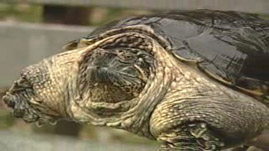Teachers' Domain - Digital Media for the Classroom and Professional Development
User: Preview

Source: Outside
In this video from the WPSU’s series Outside, a staff member from Shaver’s Creek Environmental Center at Penn State University explains how some species of turtle protect themselves in their environment. Turtles, like many other species, are facing obstacles that threaten their survival. Some of these obstacles have threatened turtle survival for centuries, while others have emerged more recently and are caused by human activities.
Special characteristics or modifications that help an organism to better survive in its environment are called adaptations. Adaptations arise as a consequence of a population’s (or gene pool’s) interaction with its habitat over generations. Some adaptations are structural or physical and are inherited from generation to generation. Other adaptations are behavioral, and can be either learned or inherited. These adaptations promote survival of an organism in its original habitat. Camouflage, defensive strategies such as the release of irritating chemicals, and protective structures such as horns, claws, and jaws are examples of adaptations to promote survival.
Turtles exhibit a wide variety of adaptations for survival. For example, the shell of the Eastern box turtle blends in with the forest floor; it also has a hinge that allows the turtle to tuck in its body and shut up tight. The stinkpot turtle exudes a yellowish-green ooze that smells musky and deters predators. The long neck and strong jaws of the aggressive snapping turtle protect a vulnerable underside.
Turtles, like many other species, are facing obstacles that threaten their survival. Some of these obstacles have threatened turtle survival for centuries, while others have emerged more recently and are caused by the actions of people. The Eastern box turtle is the most common terrestrial turtle in the eastern U.S., and is found in a variety of habitats, including swamps, forests, and agricultural fields. However, it is not immune to the pressures of extinction: habitat destruction and fragmentation threaten the long-term survival of the species.
The same is true of the tiny bog turtle. The habitat of the bog turtle is decreasing as large tracts of wetlands have been drained and developed for roads, subdivisions, and commercial tracts, or excavated for ponds. After a significant population decline over the past two decades in the mid-Atlantic and northern United States, the species is considered threatened at the federal level and endangered in some states.
Snapping turtles live in fresh or brackish water in habitats ranging from southern and eastern Canada to the southern United States. Habitat loss, cars, and water pollution are the main threats to adult snapping turtles. While most of the population is not close to extinction, one species—the alligator snapper—is threatened.
The leatherback sea turtle is endangered due to the loss of nesting habitats, encounters with boat propellers and poachers, and ingestion of plastic that they mistake for their favorite food: jellyfish. Since 1972 the United States has protected the species, but their habitats extend beyond its borders across the Atlantic, Pacific, and Indian oceans. While countries worldwide are starting to address the threats cooperatively, the number of leatherbacks on nesting beaches has declined.
To learn more about the family of turtles, check out Backyard Turtles and Desert Tortoise.
To learn more about camouflage, check out the praying mantis in Evolution of Camouflage and how spineless creatures defend themselves in Masters of Disguise.
 Loading Standards
Loading Standards